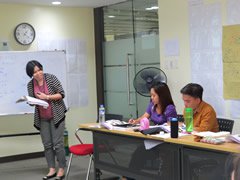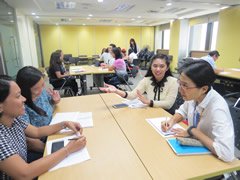2017 Japanese-Language Assistants’ Report: Conscious of the Closeness between Teaching and Learning
The Japan Foundation, Manila
MOROKUMA Yoshiko
I have been posted to the Japan Foundation, Manila (hereafter referred to as "JFM") as a Japanese-Language Assistant (hereafter referred to as "Assistant") since the end of March 2016. JFM's Japanese Language Education Group is divided into three teams, of which I belong to the secondary education Team. The main task of the secondary education team is to support Japanese-language education in Philippine high schools (equivalent to Japanese junior high and high schools), which started in 2009. I have taught Japanese in the Philippines before, but this is the first time for me to be involved in Japanese-language education in secondary schools. Also, the duties of the Assistant have changed significantly from the predecessor. I would like to introduce some of the main duties.
The "Marugoto" Class in the Training Program for Secondary School Japanese Language Teachers

Let's hear it! Are the answers correct?
Immediately after I arrived at JFM, in April 2016, the fourth phase of the Japanese-language teacher training program (hereafter referred to as "the program") for in-service high school teachers began. The program is coordinated by Japanese-Language Specialists (hereafter referred to as "Specialists"), and conducted to train teachers who can teach Japanese using the "enTree-Halina! Be a NIHONGOJIN!-" (hereafter referred to as "enTree") teaching materials for high schools developed by JFM. In order to develop the Japanese language skills of the in-service teachers (hereafter referred to as "the teachers") who participated in the program, time was set aside for Japanese language study using "Marugoto: Japanese Language and Culture, Katsudo (Coursebook for communicative language activities)" (hereafter referred to as "Marugoto") developed by the Japan Foundation (hereafter referred to as "JF"). The Assistants are primarily responsible for this time in the program in Manila. This was my first experience teaching Japanese using Marugoto, and it was a new challenge as well as a fresh experience for me.
Most of the teachers had no experience in learning Japanese and were initially confused by the teaching style of listening to CDs and guessing the meaning of new vocabulary and expressions. However, I think they gradually got used to it after having a Filipino instructor at JFM tell them that developing the ability to guess is very important for language learning. A person who can do well is not necessarily a good guesser, and many different people can take the lead in the class, saying "My guess was right!" Also, many Filipinos are shy, but when it comes to role-playing and other presentations, they sometimes perform beyond my imagination, which is one of the most pleasant moments in class.

Visitor session using the words they've learned!
In this year's program, the level of "Marugoto" has been raised from Starter (A1) to Elementary 1 (A2), and the teachers are gradually able to express themselves in Japanese. My own teaching style is still lacking and I have many issues to work on, but I hope to grow together with the teachers.
Other Duties as an Assistant
Other duties of the Assistant include assisting in the revision of the "enTree" teaching materials used at high schools, accompanying the teaching staff to high schools around Manila, and assisting in the implementation of events for secondary education. Aside from the team work, I am also creating contents for the Facebook page "NIHONGO for every Juan" created by JFM, and assisting in the operation of the "Oshaberi Salon" operated by the NIHONGO Partners. Many Specialists are sent to JFM, and it is a great learning experience for me to see the work of my seniors up close.
Future Goals
The number of Japanese language learners in the Philippines has increased significantly in recent years, but the lack of teachers is major challenge for all institutions. Therefore, many teachers, like high school teachers, are in a situation where they have to teach what they have learned immediately. In the future, I would like to keep "teaching teachers" in mind with consideration for such a situation, so that I enable teachers to immediately apply what they have learned in the classroom and can reach the students beyond the teachers. I have less than a year left of my term. Although my part will be small, I would like to broaden my horizons and help revitalize Japanese-language education, not only in the secondary schools, but also in the Philippines as a whole.
- What We Do Top
- Arts and Cultural Exchange [Culture]
- Japanese-Language Education Overseas [Language]
- Japanese-Language Education Overseas [Language] Top
- Learn Japanese-language
- Teach Japanese-language
- Take Japanese-Language Test
- Know about Japanese-language education abroad
- The Japanese-Language Institute, Urawa
- The Japanese-Language Institute, Kansai
- Japanese-Language Programs for Foreign Specified Skilled Worker Candidates
- Japanese Language Education for Japanese Children Resident Overseas and for the Descendants of Migrants
- Archives
- Japanese Studies and Global Partnerships [Dialogue]
- JF digital collection
- Other Programs / Programs to Commemorate Exchange Year
- Awards and Prizes
- Publications
